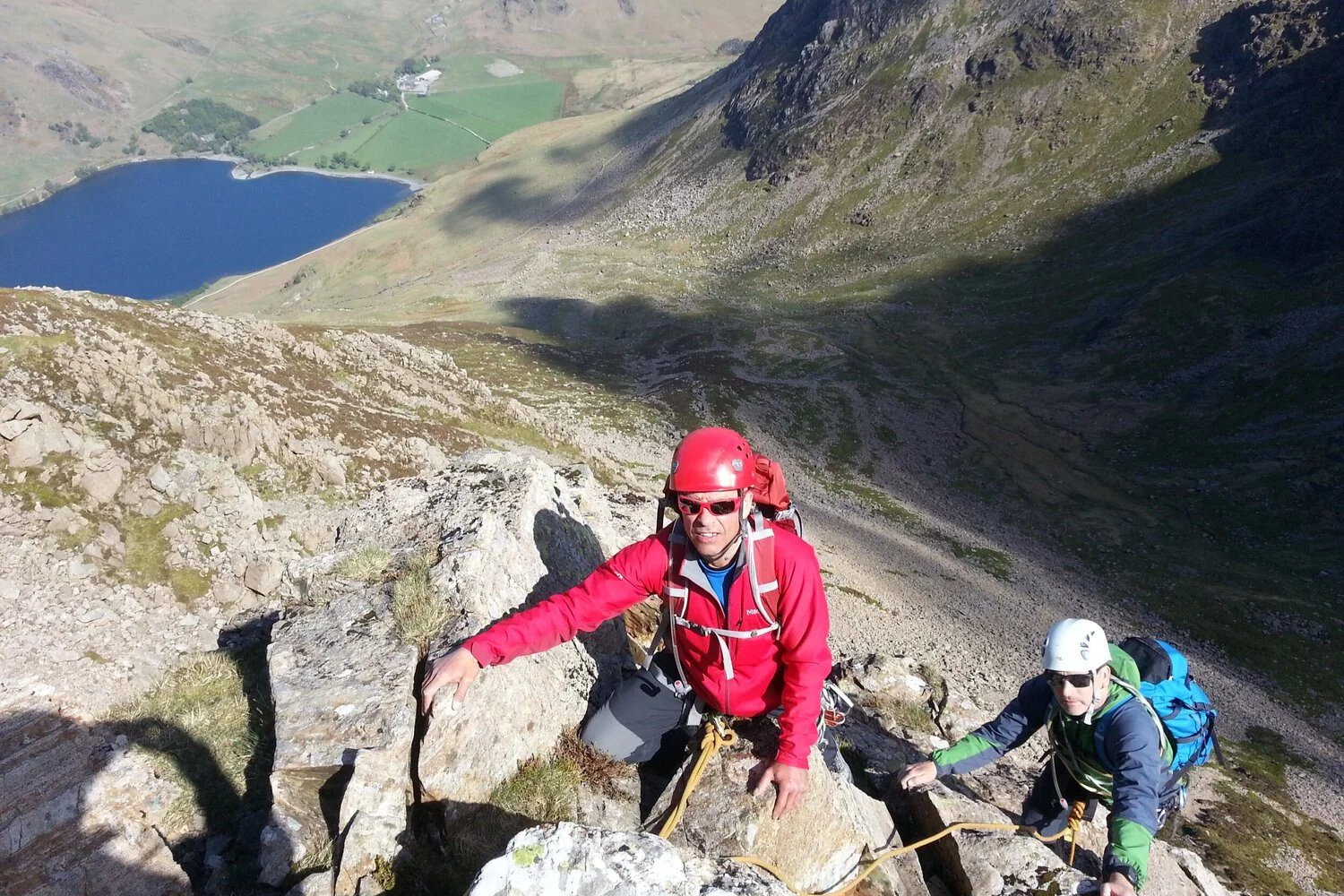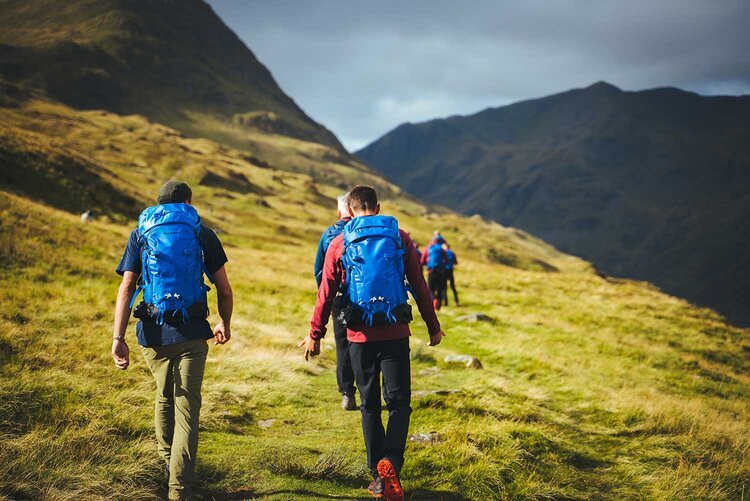How to get started mountaineering, the basics, and how to improve
There's no doubt that reaching the summit of a mountain is a moment that's hard to match. It's a heady mix of awe and achievement all rolled into one, creating the drive to find your next challenge and a memory that will last a lifetime.
But what's the safest way to learn, and where do you start?
Mountaineering doesn't have to be climbing to the summit of Mount Everest, and it can be hard-nut multi-pitch climbing up ice faces, summit scrambling, ridge walking, or even extreme backpacking. There are many opinions on what classifies as mountaineering, so don't get too bogged down with this; the focus should be on getting started effectively, no matter the level that interests you.
Mountaineering for beginners
While incredibly rewarding, there are obvious dangers that come hand in hand with being in the mountains.
This beginner's guide is a quick overview for anyone thinking of starting the journey into mountaineering and is aimed at helping you make educated and safe decisions from the start.
What are the benefits of mountaineering
There are many benefits to mountaineering. The obvious ones are related to physical health as you'll almost certainly start to utilise muscles that you might not usually use, as well as improving your cardiovascular fitness levels.
The less obvious psychological benefits are in leadership, teamwork, problem-solving, and to build confidence. These benefits also enhance your day to day life as much as your skills and expertise on the mountain.
The basics
Fitness is a crucial element of mountaineering. If you're not fit, you're going to struggle in the mountains for sure. Daily walking and stair climbing, along with cycling, running, and upper body weight training, will improve your general fitness.
At the same time, a good place to go is your local climbing wall, where you'll be able to learn the basics of using a harness, tying a rope and belaying in a safe environment, where there will be a lot of people who will happily give you free advice.
A great way to start is to get out more into the hills, making sure you take a weighted backpack. The additional weight will prepare you for the extremes you'll face in the mountains. Build up from backpacking walks to scrambling, then onto crags and ridges. Push further into roping up with a partner, and then do all of the above in winter conditions, as this will give you the best example of what mountaineering can be like.
Plan well, or plan to fail
Depending on the length of the climb, the best approach is to hit the route to it before sunrise to ensure you're giving yourself the maximum amount of time to hit the summit and get back down in the early afternoon.
Prepare to adapt; things can go wrong in the mountains, so having a backup plan ready, along with any additional clothing or gear required to sleep out if the worst happens.
If you're entirely new to mountaineering, it's always good to start as local as possible to where you're based. Choose a destination that has tried and tested routes. Don't push yourself too hard too quickly; planning on a map is different from walking and climbing the route with gear on your back, at altitude and where the weather might change around you and slow you down.
Altitude preparation
If you're planning to go higher than (3K - 3000m), then altitude is more than likely going to become a factor.
At the very least, altitude sickness can cause insomnia, lost appetite and nausea, dramatically affecting your fitness and motivation.
The very worst can cause pulmonary oedema, a potentially fatal condition.
Acclimatising yourself 'getting used to the high-altitude' is pivotal to success. Make sure you ascend slowly, camp low and only climb high. Using this basic methodology will usually allow your body to figure things out for itself. Ensure you consume plenty of food and water, even if you're not feeling thirsty or hungry. While walking and climbing, try to regulate your speed and breathing. If you become disoriented or develop a cough, it's time to get safely down the mountain quickly as possible.
Maps and navigation
The ability to navigate using various tools is essential. Almost all of the skills you need can be practised and mastered close to home by planning authentic routes. Being comfortable with tools like maps, guidebooks, GPS, altimeters, map contours, compass, bearings and sightings, and triangulation will arm you with the navigation skills you will need. Once you think you've mastered them, an idea is to purposefully get lost and use the skills to find your way home. Far better to test this for real in a safe location than in the mountains.
Correctly estimating the distance you can travel in a day is crucial in planning safely. If you're unsure of the different speeds you'll be able to travel, it's a good idea to do measured time tests on varying terrains closer to home before attempting the first attempt at a serious route. You'll notice that your pace will slow down as the terrain and weather shift. Once you understand how far you can travel, you should be capable of planning a more realistic expedition.
Choose your climbs
It's always good to think about the terrain and mountains you'd like to start with and then also set a target for what trips you'd like to tackle in the future. What you might want to climb when you're more experienced might steer where you start. Granite faces, technical routes, glaciated climbs, steep ice climbs, walk-ups or just steep slopes are a few of the terrains and difficulties on offer to you.
As a beginner, stay realistic, stay safe and learn deeply within your comfort zone. Your skills will develop in time, and your climbs and trips can progress with them.
Mountaineering - What to pack
A light backpack is essential, nothing too big due to manoeuvrability, but large enough for the essentials. When you're climbing, you'll also need a helmet, harness, the correct length of rope.
If you intend to climb on ice, make sure you use Crampons and an Ice Axe.
Due to the early starts that mountaineering sometimes requires, a head torch is always a good idea to ensure you don't get lost in the dark.
If you're planning on staying out overnight (or even if there's a chance of getting caught out), ensure you have a tent with you. Make sure it's a decent one due to the possibilities of high winds, snow and ice at high altitude, and obviously, a decent sleeping bag is vital.
Also, make sure you're emergency prepared by packing bivvy gear and a first-aid kit with essentials.
A good private guiding course with a Mountain Guide will supply some of the clothing required, so, this could be the more cost effective option than instantly investing in a lot of gear.
Mountaineering - What to wear
While mountaineering, a wide range of terrain and weather conditions can occur within a single climb in the high mountains.
A maintained path in hot weather might be your starting point; however, the higher you get, this might shift to snow, glacier travel, high winds and freezing temperatures.
Wearing layers is the pivotal to staying comfortable and as versatile as possible while mountaineering.
Below is a list of possible gear you could choose from; however, you'll need to decide which elements are best suited to the different types of mountaineering and conditions you might come up against.
A good course with a Mountain Guide will supply some of the clothing required.
Base Layers for Mountaineering include
Underwear
Bras
T-shirt
Long-underwear top
Long-underwear bottoms
Socks
Mid Layers for Mountaineering include
Fleece jacket
Soft-shell jacket
Soft-shell climbing pants
Sun hat
Liner gloves
Insulation Layers for Mountaineering include
Insulated jacket
Insulated pants
Winter hat
Glacier glasses
Midweight gloves
Gaiters
Outer Layers for Mountaineering include
Waterproof jacket
Waterproof pants
Ski goggles
Neck gaiter or balaclava
Insulated mittens
Don't rush the learning
Never rush to try something the first time on an important trip. Learn and practice in a place that you know well and where you've minimised as much risk as possible. The aim is to learn new skills well and be 100% confident in your ability to execute without issue.
Being comfortable knowing that it'll take time and many trips to master any new technique and the inevitable shift that will happen across different terrains and weather patterns.
You can glean knowledge and skills from mountaineering friends, but unless they're an official Mountain Guide, by far, the best way is by being taught by a qualified Mountain Guide on a private guiding course.
Never feel too proud to reach out for a paid service. You'll get fantastic knowledge, focused time to work on the elements you want to develop, and experience that you'll struggle to learn independently. It's altogether a safer way to grow your skill set than risk getting it wrong on your own when it really matters.
How mountaineering is taught
You'll realise that although mountaineering is incredibly rewarding, it is also vital that you acquire the necessary skills, gain confidence in your ability and upskill where you can. No matter how many of these blogs you read or videos you watch, there is no substitute for taking courses from a professional Mountain Guide on a private guiding course.
Mountain Guides or a private guiding course give you the ability to get out into the mountains quickly and safely while also ensuring you have the correct equipment, learn the proper ways to use it, and deal with issues effectively when they arise.
Mountain Guides and mountaineering courses are an excellent way for you to safely experience route planning, navigation, safe travel, rock climbing, weather analysis and mountain rescue. They will also help you with snow and ice training and crevasse rescue based on winter mountaineering.
The Mammut Mountain School UK offers you some of the best Mountain Guides and mountaineering course in the industry, and you'll use our globally envied Mammut Mountaineering equipment and clothing.
Our Private Guiding Level 1 Experience is perfect to help you make that first leap into the mountains.
No previous experience required for an amazing and memorable mountain adventure. Experience the best views that Britain has to offer, with all with the security of an experienced instructor.








